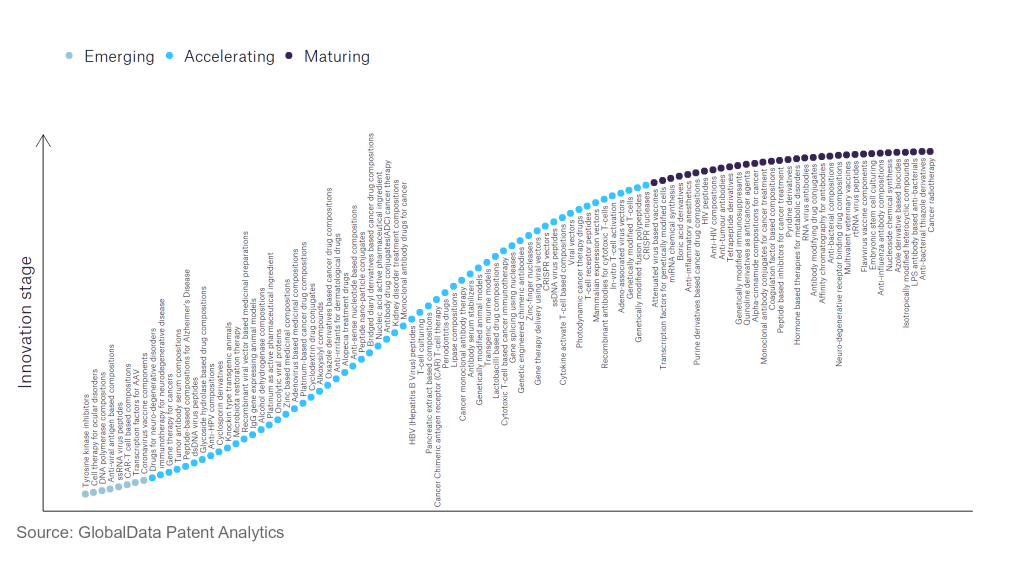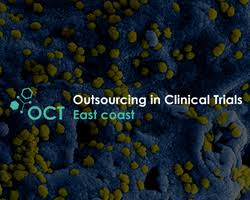The pharmaceutical industry continues to be a hotbed of innovation, with activity driven by the evolution of new treatment paradigms, and the gravity of unmet needs, as well as the growing importance of technologies such as pharmacogenomics, digital therapeutics, and artificial intelligence. In the last three years alone, there have been over 633,000 patents filed and granted in the pharmaceutical industry, according to GlobalData’s report on Innovation in Pharmaceuticals: ssRNA virus peptides. Buy the report here.
However, not all innovations are equal and nor do they follow a constant upward trend. Instead, their evolution takes the form of an S-shaped curve that reflects their typical lifecycle from early emergence to accelerating adoption, before finally stabilising and reaching maturity.
Identifying where a particular innovation is on this journey, especially those that are in the emerging and accelerating stages, is essential for understanding their current level of adoption and the likely future trajectory and impact they will have.
110 innovations will shape the pharmaceutical industry
According to GlobalData’s Technology Foresights, which plots the S-curve for the pharmaceutical industry using innovation intensity models built on over 756,000 patents, there are 110 innovation areas that will shape the future of the industry.
Within the emerging innovation stage, cell therapy for ocular disorders, coronavirus vaccine components, and DNA polymerase compositions are disruptive technologies that are in the early stages of application and should be tracked closely. Adeno-associated virus vectors, alcohol dehydrogenase compositions, and antibody serum stabilisers are some of the accelerating innovation areas, where adoption has been steadily increasing. Among maturing innovation areas are anti-influenza antibody compositions and anti-interleukin-1, which are now well established in the industry.
Innovation S-curve for the pharmaceutical industry

ssRNA virus peptides is a key innovation area in pharmaceutical
Single-stranded RNA (ssRNA) viruses establish a platform for viral replication in the cytoplasm during the early stages of infection and efficiently generate mature virus. These viruses carry the genetic information to synthesise an RNA-dependent RNA polymerase. SsRNA virus peptide-derived molecules are attractive entities because they can mimic the structural features found in RNA-binding proteins. Peptide-based therapies are versatile, highly efficacious, and have a tolerable side effect profile.
GlobalData’s analysis also uncovers the companies at the forefront of each innovation area and assesses the potential reach and impact of their patenting activity across different applications and geographies. According to GlobalData, there are 180+ companies, spanning technology vendors, established pharmaceutical companies, and up-and-coming start-ups engaged in the development and application of ssRNA virus peptides.
Key players in ssRNA virus peptides – a disruptive innovation in the pharmaceutical industry
‘Application diversity’ measures the number of different applications identified for each relevant patent and broadly splits companies into either ‘niche’ or ‘diversified’ innovators.
‘Geographic reach’ refers to the number of different countries each relevant patent is registered in and reflects the breadth of geographic application intended, ranging from ‘global’ to ‘local’.
Johnson & Johnson (J&J) is the leading patent filer in ssRNA virus peptides. J&J develops, manufactures, and sells pharmaceutical products, medical devices, and consumer products. The company provides pharmaceuticals for immune diseases, cancer, neurological disorders, infectious, cardiovascular, and metabolic diseases; consumer products in oral care, baby care, beauty, over the counter (OTC) medicines, women’s health, and wound care categories; and medical devices for use in the cardiovascular, orthopaedic, neurovascular, general surgery, and vision care fields. J&J is headquartered in New Brunswick, New Jersey, US.
GSK and C. H. Boehringer Sohn are the other key patent filers in ssRNA virus peptides.
In terms of application diversity, Eiger BioPharmaceuticals is the top company, followed by Mymetics and Amplia Therapeutics. By means of geographic reach, Artificial Cell Technologies holds the top position. While Cilian and Mymetics stand in second and third positions, respectively.
To further understand the key themes and technologies disrupting the pharmaceutical industry, access GlobalData’s latest thematic research report on Pharmaceutical.
Premium Insights
From

The gold standard of business intelligence.
Blending expert knowledge with cutting-edge technology, GlobalData’s unrivalled proprietary data will enable you to decode what’s happening in your market. You can make better informed decisions and gain a future-proof advantage over your competitors.







